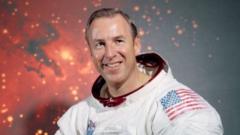Jim Lovell, the Apollo 13 astronaut renowned for his remarkable ability to guide his crew back to Earth in 1970 after a catastrophic malfunction, has passed away at 97. As a prominent figure in NASA's history, he turned a life-threatening situation into a demonstration of resilience and ingenuity. The failed moon landing attempt captured the attention of tens of millions as Lovell and his crew splashed down successfully in the Pacific Ocean, solidifying their place in space exploration history.
Born on March 25, 1928, Lovell pursued his early passion for aviation despite facing significant challenges. After losing his father at a young age, he joined the U.S. Navy, where he was trained as a pilot, combining his love of flying with his desire to work in rocketry. He eventually became one of NASA's "New Nine" astronauts, a group selected to help fulfill President Kennedy's dream of landing a man on the moon.
Lovell's journey into space began with missions such as Gemini 7 and Apollo 8, where he made a significant impact. During the Apollo 8 mission in 1968, he famously captured the iconic "Earthrise" image, emphasizing the fragility of our planet. This moment moved people worldwide and underscored the importance of unity during a tumultuous period in history.
The Apollo 13 mission, however, became Lovell's defining moment. The crew faced a critical malfunction when an oxygen tank exploded, leaving them stranded 200,000 miles from Earth. Lovell's calm leadership and problem-solving skills, alongside his crew members Fred Haise and Jack Swigert, ensured their survival and safe return, turning what could have been a tragedy into a remarkable success story.
After retiring from NASA in 1973, Lovell continued to inspire through public speaking, leadership roles, and even a film adaptation of his experiences in the 1995 movie "Apollo 13," where he was played by Tom Hanks. Lovell leaves a legacy of optimism, courage, and the belief that the impossible is achievable. His family expressed their sorrow, stating, "He was truly one of a kind," reflecting an enduring admiration for his life and accomplishments.
Born on March 25, 1928, Lovell pursued his early passion for aviation despite facing significant challenges. After losing his father at a young age, he joined the U.S. Navy, where he was trained as a pilot, combining his love of flying with his desire to work in rocketry. He eventually became one of NASA's "New Nine" astronauts, a group selected to help fulfill President Kennedy's dream of landing a man on the moon.
Lovell's journey into space began with missions such as Gemini 7 and Apollo 8, where he made a significant impact. During the Apollo 8 mission in 1968, he famously captured the iconic "Earthrise" image, emphasizing the fragility of our planet. This moment moved people worldwide and underscored the importance of unity during a tumultuous period in history.
The Apollo 13 mission, however, became Lovell's defining moment. The crew faced a critical malfunction when an oxygen tank exploded, leaving them stranded 200,000 miles from Earth. Lovell's calm leadership and problem-solving skills, alongside his crew members Fred Haise and Jack Swigert, ensured their survival and safe return, turning what could have been a tragedy into a remarkable success story.
After retiring from NASA in 1973, Lovell continued to inspire through public speaking, leadership roles, and even a film adaptation of his experiences in the 1995 movie "Apollo 13," where he was played by Tom Hanks. Lovell leaves a legacy of optimism, courage, and the belief that the impossible is achievable. His family expressed their sorrow, stating, "He was truly one of a kind," reflecting an enduring admiration for his life and accomplishments.





















